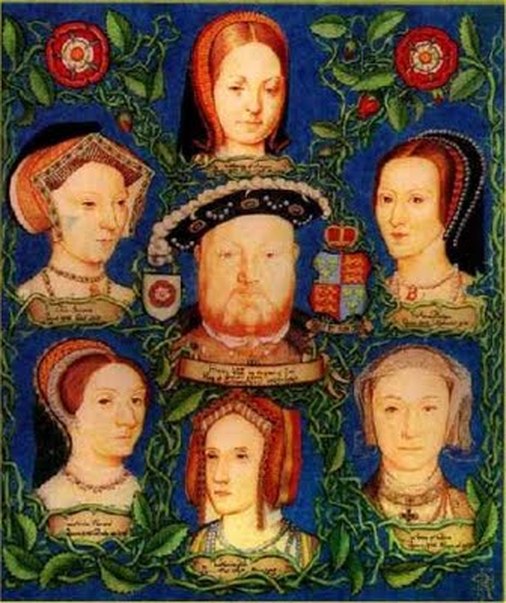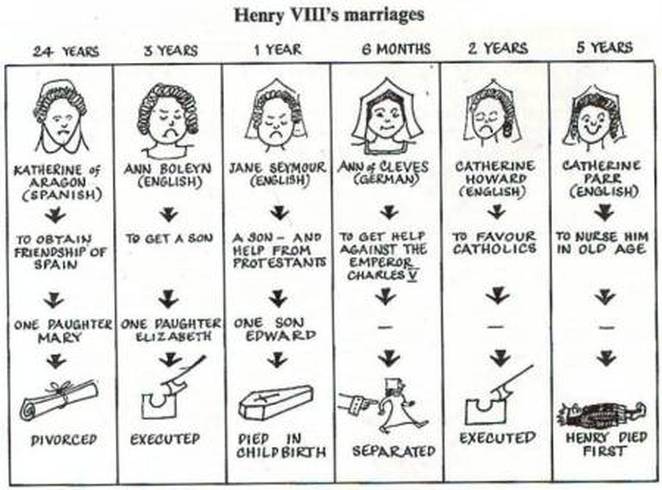Henry VIII and Tudor Times
The Six Wives
Henry VIII is arguably most famous for having six wives. In order, these are (top of graphic) Katherine of Aragon (the daughter of Ferdinand and Isabella of Spain,) Anne Boleyn (wearing her famous B necklace, on Henry VIII's right,) Jane Seymour (on Henry's left,) Anne of Cleves (at bottom right, diagonal to Henry,) Katherine Howard (cousin of Anne Boleyn, to Henry's left diagonally,) and Katherine Parr, at the bottom of the graphic. However, Henry only considered himself to have had two wives. His marriages to Katherine of Aragon, Anne Boleyn, Anne of Cleves, and Katherine Howard were all annulled. Only one of these annulments proved a happy one for the would-be bride. Due to her conformity with the wishes of the king to annul the marriage, she was reputed as "the King's most beloved sister" and was given lands and estates, which made her a wealthy woman. She outlived the king along with Katherine Parr.
Mottos of the Queens
Humble and Loyal
The Most Happy
Bound to Obey and Serve
God Send Me Well to Keep
No Will But His
To Be Useful in All I Do
The Most Happy
Bound to Obey and Serve
God Send Me Well to Keep
No Will But His
To Be Useful in All I Do
Katherine of Aragon
Anne Boleyn
Jane Seymour
Anne of Cleves
Katherine Howard
Katherine Parr
Anne Boleyn
Jane Seymour
Anne of Cleves
Katherine Howard
Katherine Parr
Although the above graphic is a good overview of the wives, it leaves out some crucial information. When Henry VIII married Katherine of Aragon, she was his brother Arthur's widow. It suited his father for him to marry Katherine and keep the alliance with the Spanish intact. Unfortunately for Katherine, Henry would use her marriage to his brother as a reason to annul their lengthy marriage when he wanted to marry Anne Boleyn. Citing Leviticus, Henry felt that God had cursed his union with Katherine because she was his brother's wife. Thus, they would have no sons, and he must find a new wife. While he certainly did want to marry Anne in the hope of having sons, he was also deeply in love with her and pursued her for several years. He even defied the Pope, who refused to grant an annulment of Henry's first marriage, and created the Church of England (still a Catholic church, but with Henry, rather than the Pope, as supreme head.) Unfortunately, the powerful Thomas Cromwell, the Lord Chancellor and Anne's one time supporter and friend, had a conflict with Anne; this brought about a desire to see her gone from power. Unfortunately for Anne, she had several miscarriages, one of which resulted in a disfigured fetus (a sure sign of God's displeasure in Tudor times.) Trumped up charges were created and Anne was convicted of adultery with five men, including her own brother. Since a Tudor queen was almost never alone, these charges were almost certainly fabricated. Anne was executed by a French swordsman, Henry's only act of mercy towards her (death by the sword was much faster and less painful than the ax.) Jane, Anne's successor, died after Edward VI's birth from childbed fever, a common cause of death among Tudor women. While Anne of Cleves, his next bride, escaped her union with Henry fairly unscathed, he despised her and was heard to yell at Thomas Cromwell, "I like her not! I like her not!" Coming from a court that was very different than that of England, where ladies were expected to dance, embroider, play cards, sing, and generally be ornaments of the court, Anne of Cleves fell desperately short. For his part in arranging the king's marriage to Anne, Thomas Cromwell was beheaded. Perhaps Christina of Milan, one of Henry's prospective brides, was right to state "had I two heads, one of them would be at his majesty's disposal." Katherine Howard, whom Henry married immediately after ridding himself of Anne of Cleves, was young, and, as queens went, the proverbial life of the party. She had somewhat too good of a time as she was caught in an adulterous affair with one young man, Thomas Culpepper, and was also found to have already been promised to another man, Francis Dereham (in Tudor times, promising the intent to marry in front of witnesses was as good as being married.) Katherine, like her cousin Anne, was executed. Finally, Katherine Parr, who had been married to two other elderly men, was last to marry the now gargantuan old king whose leg had an oozing, pus-filled, smelly ulcer (one can certainly understand Katherine Howard's youthful indiscretions.) Katherine Parr also almost lost her head. A devout Protestant reformer, she sought to instruct Henry in religion and push for religious change one too many times. Although Henry had detached England from the Pope in order to marry Anne Boleyn, he still considered himself a Catholic, and a rather conservative one at that. He was also increasingly paranoid and tyrannical as he aged, and was in no mood for an opinionated wife who did not defer to his opinions. An order for Katherine's arrest was drawn up, but before the warrant could be served, Katherine learned of the King's actions and was able to plead that she had only engaged the king in arguments to take his mind off of his painful leg. The king's ego bolstered once more, Katherine Parr was safe. She outlived the king and continued to be a loving stepmother to his children after his death.
Watch below as Henry VIII, played by Jonathan Rhys Meyer, meets Anne of Cleves, played by Joss Stone, on Showtime's The Tudors.
Watch below as Henry VIII, played by Jonathan Rhys Meyer, meets Anne of Cleves, played by Joss Stone, on Showtime's The Tudors.


